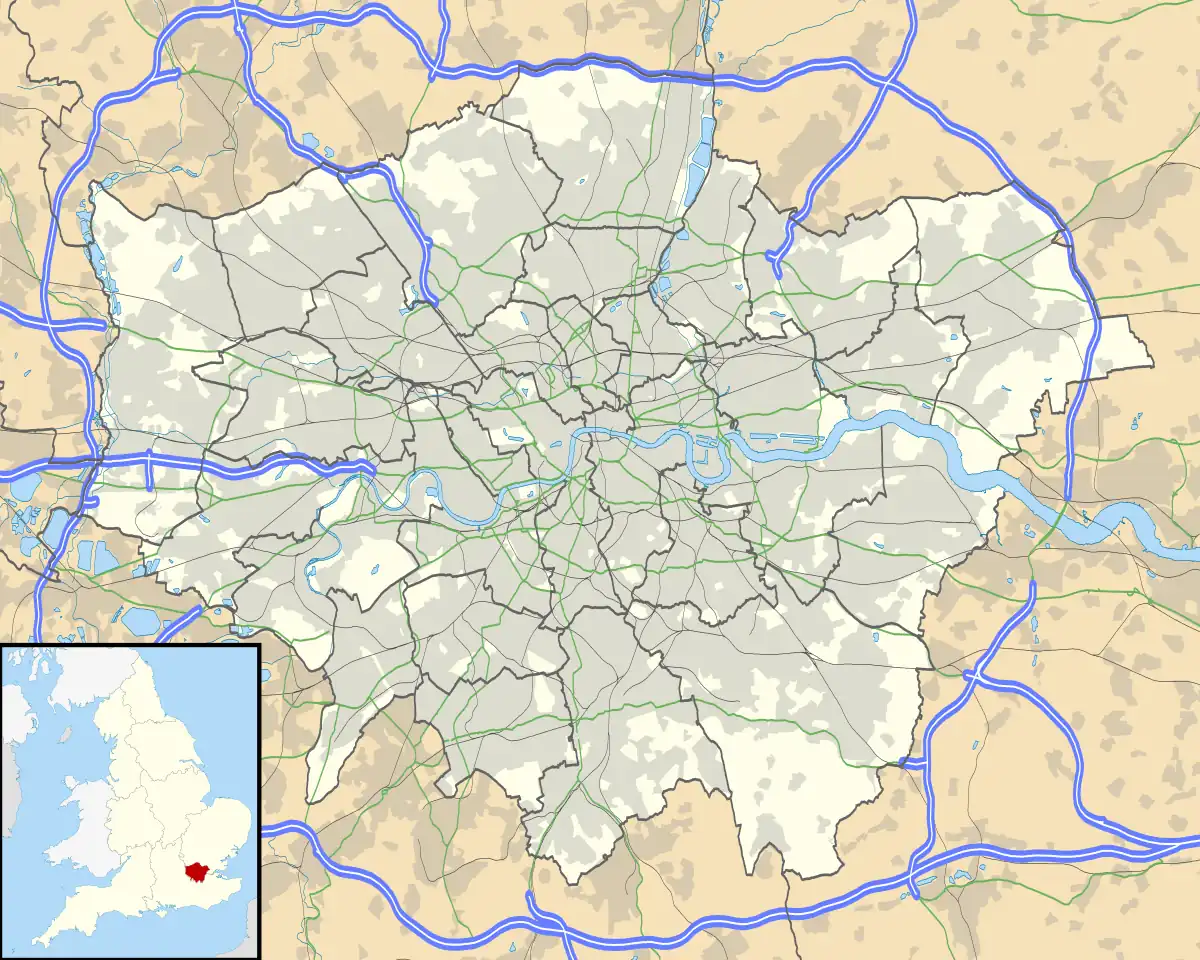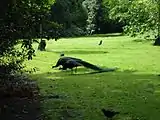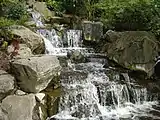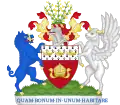Holland Park
Holland Park is an area of Kensington, on the western edge of Central London,[1] that contains a street and public park of the same name. It has no official boundaries but is roughly bounded by Kensington High Street to the south, Holland Road to the west, Holland Park Avenue to the north, and Kensington Church Street to the east. Adjacent districts are Notting Hill to the north, Earl's Court to the south, and Shepherd's Bush to the northwest.
| Holland Park | |
|---|---|
 Statue of the 3rd Baron Holland in Holland Park | |
 Holland Park Location within Greater London | |
| OS grid reference | TQ246798 |
| London borough | |
| Ceremonial county | Greater London |
| Region | |
| Country | England |
| Sovereign state | United Kingdom |
| Post town | London |
| Postcode district | W8, W11, W14 |
| Dialling code | 020 |
| Police | Metropolitan |
| Fire | London |
| Ambulance | London |
| UK Parliament | |
| London Assembly | |
The area is principally composed of tree-lined streets with large Victorian townhouses, and contains many shops, cultural tourist attractions such as the Design Museum, luxury spas, hotels, and restaurants, as well as the embassies of several countries. The street of Holland Park is formed from three linked roads constructed between 1860 and 1880 in projects of master builders William and Francis Radford, who were contracted to build and built over 200 houses in the area. Notable 19th-century residential developments in the area include the Royal Crescent and Aubrey House.
History

The district was rural until the 19th century, and most of the area now referred to by the name Holland Park was formerly the grounds of a Jacobean mansion called Cope Castle. In the later decades of that century the owners of the house sold off the more outlying parts of its grounds for residential development, and the district which evolved took its name from the house. It also included some small areas around the fringes which had never been part of the grounds of Holland House, notably the Phillimore Estate (there are at least four roads with the word Phillimore in their name) and the Campden Hill Square area.
In the late 19th century, a number of notable artists (including Frederic Leighton, P.R.A. and Val Prinsep) and art collectors lived in the area, known as the Holland Park Circle, especially in Melbury Road and Holland Park Road.
Lansdowne House
Lansdowne House, at Lansdowne Road. is a Grade II listed eight-storey building which was originally constructed in 1902–04 by Scottish architect William Flockhart,[2] for South African mining magnate Sir Edmund Davis. The building contained apartments and artists' workshops. Among the artists who had studios in the building in the early decades of the 20th century were Charles Ricketts, Charles Haslewood Shannon, Glyn Philpot, Vivian Forbes, James Pryde, and Frederick Cayley Robinson, who are commemorated on a blue plaque on the building.[3]
The building underwent significant alterations. When, in 1957, record producer Denis Preston was looking for a property in which to set up a recording studio, his assistant engineer Joe Meek found the premises, which had unusually high ceilings and a basement squash court, suitable for conversion into a studio. Preston, Meek and engineer Adrian Kerridge then established the studio, and made their first recordings there in 1958. The studio was London's first independent music recording studio.[4] In 1962, an enlarged control room overlooking the studio floor was opened. Kerridge later became the studio's owner.[5] The studios closed in 2006 and the building was subsequently converted into 13 self-contained apartments, while retaining a small recording studio.[3]
The public park
 Peacocks in Holland Park
Peacocks in Holland Park The formal gardens
The formal gardens.jpg.webp) Formal gardens, looking towards Holland House
Formal gardens, looking towards Holland House The Kyoto Garden
The Kyoto Garden Kyoto Garden waterfall
Kyoto Garden waterfall
The park covers about 22 hectares (54 acres),[6] with a northern half of semi-wild woodland, central section of formal garden areas, and southernmost section used for sport.
Holland House is now a fragmentary ruin, having been devastated by incendiary bombing during the Second World War in 1940, but the ruins and the grounds were bought by London County Council in 1952 from the last private owner, the 6th Earl of Ilchester.[7] Today the remains of the house form a backdrop for the open air Holland Park Theatre, which is the home of Opera Holland Park. To the immediate south of the park is the former site of the Commonwealth Institute, now home to the Design Museum.
The park contains a café, as well as the Belvedere Restaurant that is attached to the orangery, a giant chess set,[8] a cricket pitch, tennis courts, two Japanese gardens - the Kyoto Garden (1991) and Fukushima Memorial Garden (2012),[9] a youth hostel, a children's playground, squirrels and peacocks. In 2010, the park set aside a section for pigs whose job was to reclaim the area from nettles etc., in order to create another meadow area for wildflowers and fauna. Cattle were used subsequently to similar effect.
The Holland Park Ecology Centre (2013), operated by the borough's Ecology Service, provides environmental education programmes including nature walks, talks, programmes for schools, and outdoor activity programs for children.[10]
.jpg.webp)
In the northwest of the park near Abbotsbury Road, installed in 2000, is the outdoor sculpture Tortoises with Triangle and Time by Wendy Taylor, commissioned by the Royal Borough of Kensington and Chelsea for the Millennium.[11]
References
- "Policy 2.5 Sub-regions". The London Plan. Greater London Authority. 2016. Retrieved 13 March 2019.
- "Lansdowne House", Directory of Scottish Architects. Retrieved 23 May 2020
- "Lansdowne House", Buildington.co.uk. Retrieved 23 May 2020
- "Adrian Kerridge RIP", Institute of Professional Sound, 11 August 2019. Retrieved 24 May 2020
- Howard Massey, The Great British Recording Studios, Hal Leonard Corporation, 2015, pp.
- "Parks & Gardens UK Holland Park, Kensington, England". web page. Copyright Parks and Gardens Data Services Ltd. 2012. Retrieved 28 January 2013.
- "Parks and Gardens UK". Archived from the original on 26 February 2012. Retrieved 27 September 2009.
- "Making mates on giant chessboard in Holland Park | News". Thisislondon.co.uk. 1 November 2010. Retrieved 25 September 2011.
- Pylant, Don. "Holland Park's Fukushima Garden – London | Japanese Gardening". Retrieved 8 July 2019.
- "About the Holland Park Ecology Centre". Royal Borough of Kensington and Chelsea. Retrieved 7 September 2023.
- "Tortoises with Triangle and Time". Art UK. Retrieved 7 September 2023.


